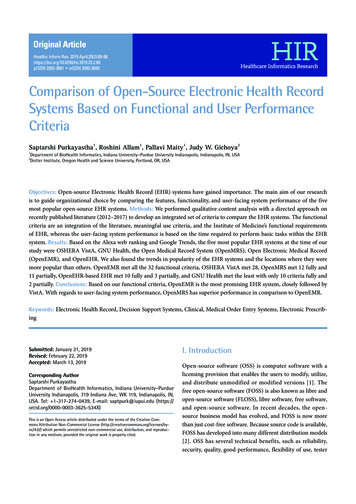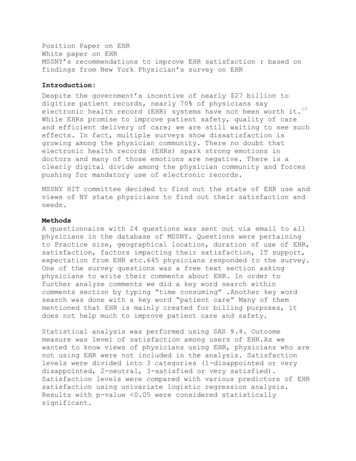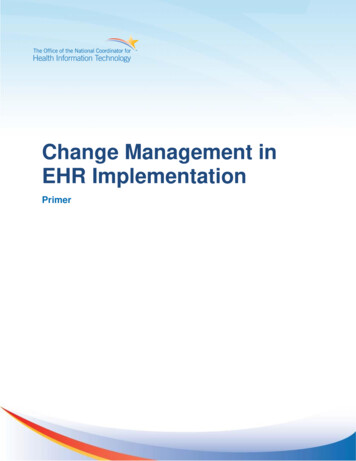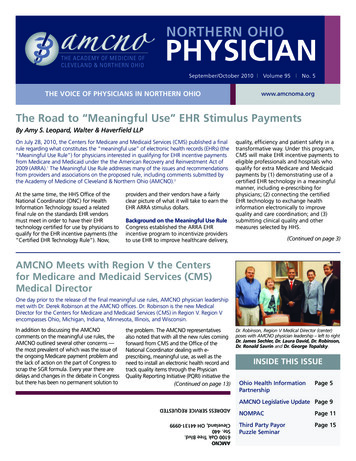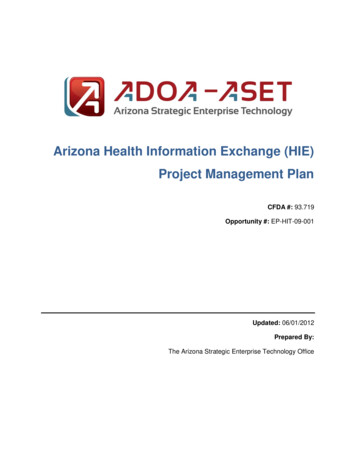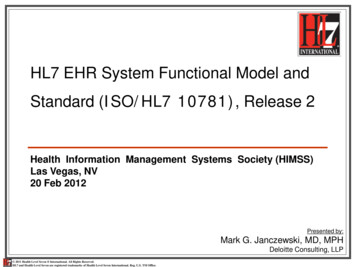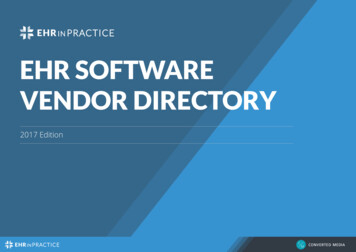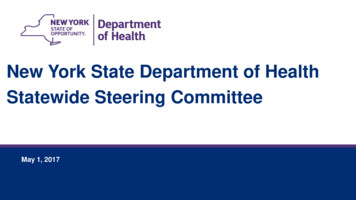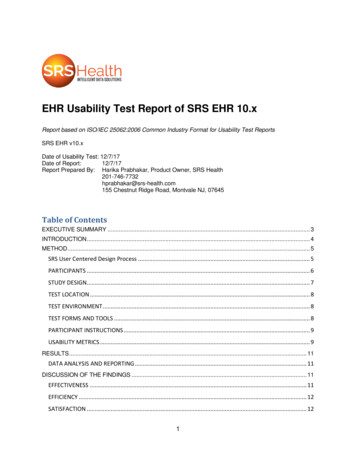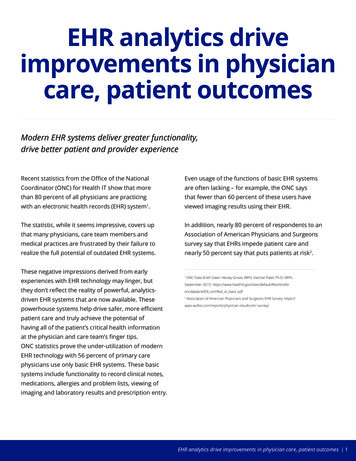
Transcription
EHR analytics driveimprovements in physiciancare, patient outcomesModern EHR systems deliver greater functionality,drive better patient and provider experienceRecent statistics from the Office of the NationalEven usage of the functions of basic EHR systemsCoordinator (ONC) for Health IT show that moreare often lacking – for example, the ONC saysthan 80 percent of all physicians are practicingthat fewer than 60 percent of these users havewith an electronic health records (EHR) system .viewed imaging results using their EHR.The statistic, while it seems impressive, covers upIn addition, nearly 80 percent of respondents to anthat many physicians, care team members andAssociation of American Physicians and Surgeonsmedical practices are frustrated by their failure tosurvey say that EHRs impede patient care andrealize the full potential of outdated EHR systems.nearly 50 percent say that puts patients at risk2.1These negative impressions derived from earlyexperiences with EHR technology may linger, butthey don’t reflect the reality of powerful, analyticsdriven EHR systems that are now available. Thesepowerhouse systems help drive safer, more efficient1ONC Data Brief, Dawn Heisey-Grove, MPH; Vaishali Patel, Ph.D, MPH,September 2015: s/oncdatabrief28 certified vs basic.pdf2Association of American Physicians and Surgeons EHR Survey: hr-survey/patient care and truly achieve the potential ofhaving all of the patient’s critical health informationat the physician and care team’s finger tips.ONC statistics prove the under-utilization of modernEHR technology with 56 percent of primary carephysicians use only basic EHR systems. These basicsystems include functionality to record clinical notes,medications, allergies and problem lists, viewing ofimaging and laboratory results and prescription entry.EHR analytics drive improvements in physician care, patient outcomes 1
Different story for newEHR systemsMuch of the frustration with EHR systems expressed byAdvances in EHR systems also enable healthcarehealthcare providers can be traced to systems built toorganizations and users to deliver higher quality careachieve the Centers for Medicare & Medicaid Servicesthat is actually safer for patients, instead of giving(CMS) definition of Meaningful Use.physicians reasons to believe they impede safety.When the government began to pay incentiveThe misconceptions physicians and even healthcarepayments to physicians to adopt EHR systems,administrators have about the real capabilities of EHRMeaningful Use was intended to be the way to provesystems continue to be shaped by early experience.that the system was actually being installed and used inPhysicians who were early adopters of EHR technologythe delivery of patient care.or those never fully trained on the functionality aremore likely to see EHR systems as only a way to collectAs vendors built systems to achieve these objectives,encounter documentation and store the patient healthoften neglected was the role the EHR could play inrecords.allowing a whole healthcare team to improve the actualdelivery of care. Users expected more than a systemYet, like virtually all technology now in use, the toolsthat just made it easier to store records in a way thatand functionality of EHR systems are improving atwas more cost-effective and took up less space.a rapid rate. EHR vendors have heard complaintsfrom physicians and healthcare systems; therefore,Driven by advances in technology and user feedback,continuing to design new technology that is driving theEHR systems now feature added functionality designedrevolution in EHR usability with the promise of careto make systems easier to use by physicians and otherdelivery focused on improvements in quality, efficiencyproviders to deliver care more efficiently.and safety.EHR analytics drive improvements in physician care, patient outcomes 2
Quality driven by evidencebased care, active participationOne of the biggest ways EHR systems add value to practice operations is the capabilityto provide evidence based recommendations to aid physicians in making the righttreatment decisions.The medical records being a repository for informationOrder sets provide recommendations to providershave truly gone away. Clinical decision support whenbased on best practices for things ranging from bestit comes to prescribing medications, presentingcare for a diabetic patient to appropriate preventiveinformation as to why a certain medication, procedurecare for a healthy adult.or test may be recommended for a patient based uponother factors in their health record, helps provideUsers should expect the best EHR systems to deliverbetter care and improve medical decision making.information to the care team that makes it actionableto help engage the patient to fill in gaps in the record.When physicians lack clinical decision support, they arebecoming more frustrated and asking for EHR systemsthat can deliver more than just a system for data entry.Physicians and care team members can get accessto the latest evidence-based care recommendationsto help guide medical decision making for a patient,whether it’s primary or specialty care.EHR analytics drive improvements in physician care, patient outcomes 3
Efficiency in providerworkflows andpatient encountersAnalytics-backed EHR systems also take what was one of the biggest frustrations ofphysician users – that the EHR actually slows them down – and creates apositive user experienceAvailability of real-time analytics – something lessThe analytics component of the EHR system automatesthan 3 percent of physicians currently have, accordingmanual activities done by physicians and care teamto a recent poll in Transitioning to Value-Based Caremembers, such as track Meaningful Use. It takesUsing Real-Time Analytics webinar hosted by Medicalthe burdens off of the physician and enables themGroup Management Association (MGMA) – is a gameto focus more intently on providing quality care.changer when it comes to greatly improved patientcare, EHR usability and physician satisfaction.Population Health Management is one key area wherean analytics-based EHR is a difference maker. It enablesthe practice to identify patients with care gaps and takeaction at the individual patient level – without the needfor the involvement of the physician. The care teamcan intervene with the patient before a hospitalization,from key information delivered in real time.The care team can see from the data that thereare complex issues with a patient, and the systemnotifies the care team to get the patient in for a visit.It helps the care team prioritize the patients that theycontact with a secure message, phone call or letter.EHR analytics drive improvements in physician care, patient outcomes 4
Improved patient safetyPatient safety is improved by ensuring patient-The patient also benefits by being brought in as anspecific information such as lab and test results areactive participant in his or her own care. The abilityautomatically ported into the patient encounters.to have results available at the time of the encounterTherefore, when the physician comes face-to-faceallows the physician to intervene face-to-face at thewith the patient, he or she doesn’t need to go find thepoint of care, in which the patient is more likely to staypatient’s data because it’s already there.in compliance with follow-up activity.The doctor has the data on the device he or she bringsFinally, patients or authorized family members engagedinto the exam room, so things such as x-ray imageswith the portal are able to view their health measurescan be shared with the patient right in the room. Laboutside of office visits to see whether they are at theirresults can be immediately brought up and trended togoals for specific conditions.realize patterns.Additionally, with a system that provides detailedcare plans with goals, physicians and the care teamcan leverage the medical record to help educate andmotivate patients to change. These are very powerfultools as part of motivational interviewing and shareddecision making with patients.EHR analytics drive improvements in physician care, patient outcomes 5
The emerging benefitsWell-designed, analytics-driven EHR systemsAbout MCIS, Inc.:have gone well beyond just being a mechanismto help physicians and healthcare groups achieveMCIS, Inc. was established from within the Marshfieldincentives from programs and being a way to ridClinic Health System, and has been continuouslythe office of file cabinets full of patient records.developing an EHR for providers for over 30 years. Thecompany understands the challenges that practicesAs with most technology, EHR vendors have adaptedface, and empowers physicians to do what they wereto frustrations with previous user experience tointended to do, which is practice medicine, withdesign seamless, patient and provider-friendlyexpert clinical decision support when they need it.experiences that capitalize on the bold promises ofelectronic health records – the delivery of improved,For more information, go to www.mcis.com.more efficient patient-care that’s data driven androoted in best practices for positive outcomes.EHR analytics drive improvements in physician care, patient outcomes 6
Published by:MCIS, Inc.1701 N Fig AvenueMarshfield, WI 54449(866) 456-0366solutions@mcis.comCopyright 2016 MCIS, Inc.All rights reserved.No part of the contents of this publicationmay be reproduced or transmitted inany form or by any means without thewritten permission of MCIS, Inc.The MCIS logo is a registered trademarkin the United States. All Rights Reserved.www.mcis.comEHR analytics drive improvements in physician care, patient outcomes 7
and functionality of EHR systems are improving at a rapid rate. EHR vendors have heard complaints from physicians and healthcare systems; therefore, continuing to design new technology that is driving the revolution in EHR usability with the promise of care delivery focused on improvements in quality, efficiency and safety.

